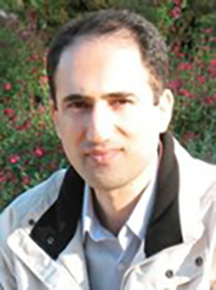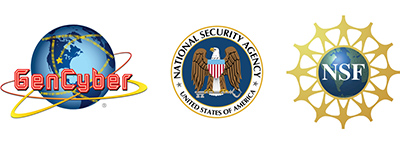Thomas Oommen (DataS/GMES/EPSSI) is Principal Investigator on a project that has received a $39,999 research and development grant from the US Department of State. The project is titled, “Developing and Improving Disaster Management Studies Course in India.” This is a one-year project.
The Michigan Tech College of Computing offers a full range of undergraduate and graduate degrees in the Computing disciplines.
 Timothy Havens (CC/ICC) was General Co-Chair of the 2019 IEEE International Conference on Fuzzy Systems in New Orleans, LA, June 23 to 26. At the conference, Havens presented his paper, “Machine Learning of Choquet Integral Regression with Respect to a Bounded Capacity (or Non-monotonic Fuzzy Measure),” and served on the panel, “Publishing in IEEE Transactions on Fuzzy Systems.”
Timothy Havens (CC/ICC) was General Co-Chair of the 2019 IEEE International Conference on Fuzzy Systems in New Orleans, LA, June 23 to 26. At the conference, Havens presented his paper, “Machine Learning of Choquet Integral Regression with Respect to a Bounded Capacity (or Non-monotonic Fuzzy Measure),” and served on the panel, “Publishing in IEEE Transactions on Fuzzy Systems.”
Three additional papers authored by Havens were published in the conference’s proceedings: “Transfer Learning for the Choquet Integral,” “The Choquet Integral Neuron, Its PyTorch Implementation and Application to Decision Fusion,” and “Measuring Similarity Between Discontinuous Intervals – Challenges and Solutions.”
 Zhuo Feng (ECE/ICC) is Principal Investigator on a project that has received a $500,000 research and development grant from the National Science Foundation. This potential three-year project is titled, “SHF: Small: Spectral Reduction of Large Graphs and Circuit Networks.”
Zhuo Feng (ECE/ICC) is Principal Investigator on a project that has received a $500,000 research and development grant from the National Science Foundation. This potential three-year project is titled, “SHF: Small: Spectral Reduction of Large Graphs and Circuit Networks.”
This research project will investigate a truly-scalable yet unified spectral graph reduction approach that allows reducing large-scale, real-world directed and undirected graphs with guaranteed preservation of the original graph spectra. Unlike prior methods that are only suitable for handling specific types of graphs (e.g. undirected or strongly-connected graphs), this project uses a more universal approach and thus will allow for spectral reduction of a much wider range of real-world graphs that may involve billions of elements:
- spectrally-reduced social (data) networks allow for more efficiently modeling, mining and analysis of large social (data) networks;
- spectrally-reduced neural networks allow for more scalable model training and processing in emerging machine learning tasks;
- spectrally-reduced web-graphs allow for much faster computations of personalized PageRank vectors;
- spectrally-reduced integrated circuit networks will lead to more efficient partitioning, modeling, simulation, optimization and verification of large chip designs, etc.
From Tech Today, June 21, 2019
 The article “Topology-Specific Synthesis of Self-Stabilizing Parameterized Systems With Constant-Space Processes,” authored by Ali Ebnenasir (SAS/CS) and Alex Klinkhamer, has been accepted for publication in the journal IEEE Transactions on Software Engineering. Read the full article here: https://ieeexplore.ieee.org/document/8651426.
The article “Topology-Specific Synthesis of Self-Stabilizing Parameterized Systems With Constant-Space Processes,” authored by Ali Ebnenasir (SAS/CS) and Alex Klinkhamer, has been accepted for publication in the journal IEEE Transactions on Software Engineering. Read the full article here: https://ieeexplore.ieee.org/document/8651426.
 Soner Onder (SAS, CS) will present a keynote address titled “Form Follows Function: The Case for Continuing ILP and General Purpose Computing Research” at the International Conference on Embedded Computer Systems: Architectures, Modeling and Simulation (SAMOS XIX), Samos Island, Greece, on July 7, 2019.
Soner Onder (SAS, CS) will present a keynote address titled “Form Follows Function: The Case for Continuing ILP and General Purpose Computing Research” at the International Conference on Embedded Computer Systems: Architectures, Modeling and Simulation (SAMOS XIX), Samos Island, Greece, on July 7, 2019.
 The article “Topology-Specific Synthesis of Self-Stabilizing Parameterized Systems With Constant-Space Processes,” authored by Ali Ebnenasir (SAS/CS) and Alex Klinkhamer, has been accepted for publication in the journal IEEE Transactions on Software Engineering. Read the full article here: https://ieeexplore.ieee.org/document/8651426
The article “Topology-Specific Synthesis of Self-Stabilizing Parameterized Systems With Constant-Space Processes,” authored by Ali Ebnenasir (SAS/CS) and Alex Klinkhamer, has been accepted for publication in the journal IEEE Transactions on Software Engineering. Read the full article here: https://ieeexplore.ieee.org/document/8651426
Kelly Steelman (CLS) has been selected from a competitive pool of applicants to participate in the Human Factors and Ergonomics Society (HFES) Science Policy Fellowship program.
The HFES Science Policy Fellows (SPF) program provides a valuable opportunity for HFES members to learn how to successfully advocate for human factors and ergonomics on the national stage. SPF Participants will receive extensive training in public affairs, advocacy and outreach to be provided by Lewis-Burke Associates and the HFES Government Relations Committee during the HFES Annual Meeting. They will also participate in an annual spring Capitol Hill Day in Washington, D.C., including a Hill visit training session and a policy-related speaker prior to the visit day. They will be invited to attend monthly conference calls with Lewis-Burke and the HFES Government Relations Committee covering ongoing events and opportunities for HFES to engage in policy decisions.
Following an initial one-year term in the SPF program, each program graduate will commit to two years of service in an outreach capacity. They will create a customized plan that may include continued participation in the Capitol Hill day and interactions with policymakers in Washington, DC, working at the local/state level, serving on the GRC or a subcommittee, and other forms of outreach developed by each participant. HFES SPF participants and graduates will form the basis of a future brain trust with expertise in outreach creating a pipeline of politically engaged and knowledgeable members within HFES.
 ICC Director Tim Havens (DataS) presented an invited talk, “Explainable Deep Fusion,” at the Technological University of Eindhoven, The Netherlands, on May 7, 2019.
ICC Director Tim Havens (DataS) presented an invited talk, “Explainable Deep Fusion,” at the Technological University of Eindhoven, The Netherlands, on May 7, 2019.
Like a winning trivia team, sensor fusion systems seek to combine cooperative and complementary sources to achieve an optimal inference from pooled evidence. In his talk, Havens introduced data-, feature-, and decision-level fusions and discussed in detail two innovations he has made in his research: non-linear aggregation learning with Choquet integrals and their applications in deep learning and Explainable AI (XAI).

 By Karen S. Johnson, ICC Communications Director
By Karen S. Johnson, ICC Communications Director
We live in a world where pretty much everything and everybody – individuals, companies, governments, critical infrastructure – are increasingly dependent on connected systems, networks and devices. And, as newspaper headlines reveal, those systems may be insecure and vulnerable to hackers.
“Nowadays, everybody is using computers, and more and more things are connected. That provides convenience, flexibility, a lot of great things, but it also opens the doors for hackers,” says Yu Cai, associate professor and program chair for the Computer Network and System Administration program at Michigan Technological University.
“The world has increasingly become a combination of the physical world and the cyber world,” Cai adds. “That’s why cybersecurity is important, because you want to protect yourself. As human beings, we evolved over thousands of years to take care of our security in the physical world. But in the cyber world, many don’t have a very good idea of how to protect themselves.”
Cai is principal investigator on two grant awards, each for about $85K, which are making possible two free, non-residential, week-long GenCyber summer camps on Michigan Tech’s campus. The first camp, for middle school and high school students, is the week of June 17. The second camp, for K-12 STEM teachers, is the week of August 12. Both camps and all learning materials are offered at no cost to camp participants. Each participant will receive a Raspberry Pi minicomputer. Breakfast and lunch are provided. For enrollment information, visit mtu.edu/gencyber.
Funded jointly by the National Security Agency (NSA) and the National Science Foundation (NSF), the goals of the nationwide GenCyber program are to increase interest in cybersecurity careers and diversity in the national cybersecurity workforce, help students understand correct and safe on-line behavior and how they can be good digital citizens, and improve teaching methods for delivery of cybersecurity content in K-12 curricula.
“This is part of our picture to make Michigan Tech a leader in cybersecurity research and education,” Cai says of this summer’s GenCyber camps. “We have other cybersecurity curriculum development grants that focus on college education, now we want to outreach to K through 12.”
In both camp sessions, participants will explore the world of cybersecurity through real-world case studies, hands-on learning activities and games, interactive lectures, career exploration, and field trips. Covered topics include safe online behavior, cyber ethics, fundamental computer and network knowledge, and cybersecurity career options and educational opportunities.
“We’ll also cover common vulnerabilities and weaknesses of computer systems, such as how hackers get into the systems, and how systems can be strengthened to defeat hackers against the hundreds of vulnerabilities,” Cai adds.
Tim Van Wagner, a lecturer at Michigan Tech and a co-PI on the grants, is the lead teacher for the camps. Cai and his other co-PIs—associate professor Guy Hembroff and assistant professor Bo Chen—will also present learning modules and assist with the camps.
K-12 pedagogical expertise in curriculum development was provided by Copper Country Intermediate School District (CCISD) staff members Emily Gochis, Director of the Region 16 MiSTEM Network, and Steve Kass, Educational Technologist.
“Steve and Emily provided a lot of input and suggestions regarding the camp curriculum and advised us in the best practices for teaching high school students,” Cai says, adding that they are also helping to promote the camps in local public schools.
Driving the curriculum are four principles: Learning by Storytelling, Learning by Doing, Learning by Gaming, and Learning by Teaching. Cai and his team will be assessing the effectiveness of these principles using several methods. The resulting research will be shared with the GenCyber program and the public.
The two grants are titled, “Innovative GenCyber Learning Experience for K-12 Teachers Through Storytelling + Teaching + Gaming + Doing” and “Innovative GenCyber Learning Experience for High School Students Through Storytelling + Teaching + Gaming + Doing.”
 Tim Havens (CS/ICC) coauthored the article, “Enabling Explainable Fusion in Deep Learning with Fuzzy Integral Neural Networks,” which was accepted for publication in the journal IEEE Transactions on Fuzzy Systems.
Tim Havens (CS/ICC) coauthored the article, “Enabling Explainable Fusion in Deep Learning with Fuzzy Integral Neural Networks,” which was accepted for publication in the journal IEEE Transactions on Fuzzy Systems.
Citation: M.A. Islam, D.T. Anderson, A. Pinar, T.C. Havens, G. Scott, and J.M. Keller. Enabling explainable fusion in deep learning with fuzzy integral neural networks. Accepted, IEEE Trans. Fuzzy Systems.
Abstract: Information fusion is an essential part of numerous engineering systems and biological functions, e.g., human cognition. Fusion occurs at many levels, ranging from the low-level combination of signals to the high-level aggregation of heterogeneous decision-making processes. While the last decade has witnessed an explosion of research in deep learning, fusion in neural networks has not observed the same revolution. Specifically, most neural fusion approaches are ad hoc, are not understood, are distributed versus localized, and/or explainability is low (if present at all). Herein, we prove that the fuzzy Choquet integral (ChI), a powerful nonlinear aggregation function, can be represented as a multi-layer network, referred to hereafter as ChIMP. We also put forth an improved ChIMP (iChIMP) that leads to a stochastic gradient descent-based optimization in light of the exponential number of ChI inequality constraints. An additional benefit of ChIMP/iChIMP is that it enables eXplainable AI (XAI). Synthetic validation experiments are provided and iChIMP is applied to the fusion of a set of heterogeneous architecture deep models in remote sensing. We show an improvement in model accuracy and our previously established XAI indices shed light on the quality of our data, model, and its decisions.
